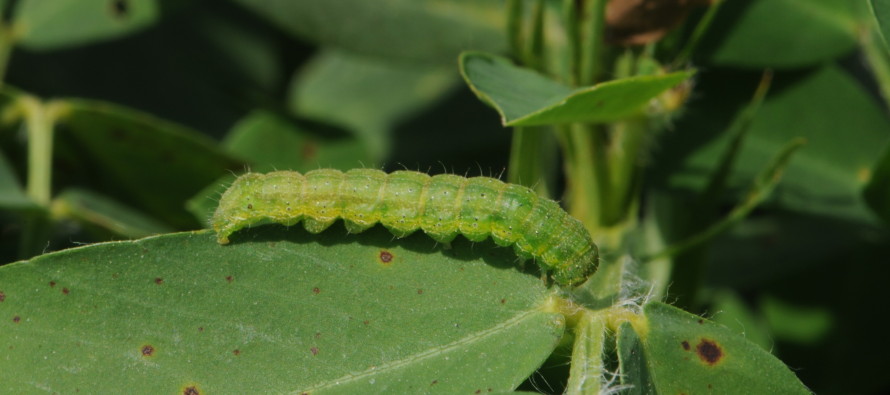Defoliating Caterpillars in Peanuts

Related Articles
- Evaluation of Peanut Varieties in Mississippi, 2010 0
- Evaluation of Peanut Prescription Rx Program in Mississippi 0
- Evaluation of Tillage Systems as Related to Peanut Yield 0
Latest Tweets
We have had numerous calls over the last 2 weeks about caterpillars in peanut from all around the state. In every case, the calls have involved a complex of multiple species including bollworm/tobacco budworm, cutworms, armyworms, saltmarsh caterpillar, loopers, and rednecked peanut worm.
 For the most part, feeding is similar for all of these species. As such, our current threshold is the same for all species, except rednecked peanut worm. The threshold for each species is 4 per row foot early in the season or when peanuts are stressed, and 8 per row foot in older more lush peanuts. Because their feeding is similar, all species can be added together to make a decision about whether or not to spray.
For the most part, feeding is similar for all of these species. As such, our current threshold is the same for all species, except rednecked peanut worm. The threshold for each species is 4 per row foot early in the season or when peanuts are stressed, and 8 per row foot in older more lush peanuts. Because their feeding is similar, all species can be added together to make a decision about whether or not to spray.

One of the biggest questions I have had is about when to stop spraying peanuts for worms. The graph to the left shows some research we did last year to look at the impact of defoliation at different timings on peanut yields. All of these plots received 100% defoliation at different times throughout the season ranging from 35 to 110 days after planting. Once we got to 110 days, we didn’t see any yield loss from 100% defoliation. Also, the greatest yield loss occurred when we defoliated the peanuts at 80 days after planting. Remember, this is from 100% defoliation and even moderate levels of defoliation don’t scare me too bad this late in the season.
We are currently working toward developing a defoliation threshold for caterpillar pests in peanuts. One of Dr. Sarver’s graduate students, Mr. Chad Abbott, has taken over the defoliation research and we are looking at different levels of defoliation at different times during the growing season. We are currently finishing up the first year of his research in Starkville and Stoneville. We will likely have a better idea about what level of defoliation we need to be worried about after this season, but we will not have a formal threshold until we get at least 2 years worth of research.
In terms of what to spray, a lot of insecticides targeting caterpillars work a lot better in peanuts than they do in other crops. This is especially true for bollworms and tobacco budworms. The diamides (Belt, Prevathon, and Besiege) are outstanding insecticides, but peanut is one crop where we have some other really good options that we can use to take some pressure off of the diamides. Some other options include Diamond, Intrepid, Intrepid Edge, and Steward are all good options to control the whole complex.
I know a lot of these insecticides don’t provide good control of bollworm and tobacco budworm in other crops, but they tend to work a lot better in peanut. This is probably a dose issue. All of these insecticides have to be ingested by the larvae so their feeding habit is very important to achieve good control. In cotton or soybean, they are feeding on the fruit (cotton bolls or soybean pods) of the plant. In peanuts, they feed exclusively on leaves. They have to eat a lot more leaves than they do fruiting structures to develop normally, so they ingest a much greater dose of the insecticide in peanuts than they would cotton or soybeans. I have even seen decent control of bollworms with Intrepid and Diamond in peanuts even though they are insecticides we would never recommend in other crops.
The bottom line is that in peanuts we can get similar levels of control with multiple insecticides, use alternatives to the diamides, and in many cases save a little money.




Let me tell You a sad story ! There are no comments yet, but You can be first one to comment this article.
Write a comment